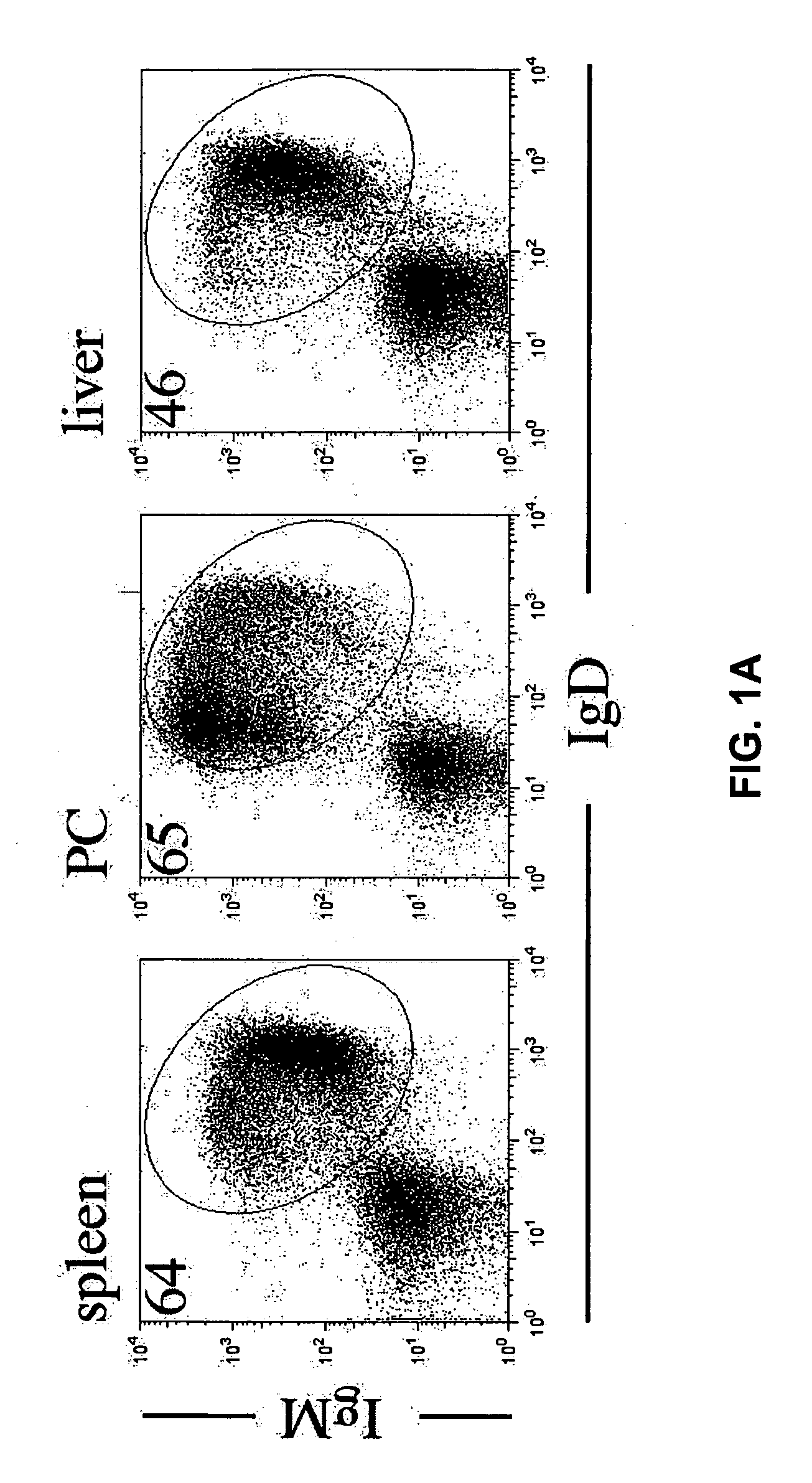Methods for treating fibrotic conditions
a fibrotic condition and treatment method technology, applied in the field of fibrotic condition treatment, can solve the problems of organ failure and death, and achieve the effect of substantially reducing the extent of experimentally-induced fibrosis injury
- Summary
- Abstract
- Description
- Claims
- Application Information
AI Technical Summary
Benefits of technology
Problems solved by technology
Method used
Image
Examples
example 1
Attenuated Liver Fibrosis in the Absence of B-Cells
Introduction
[0195] The hallmarks of chronic liver diseases, such as alcohol-induced liver degeneration, hepatitis C infection, non-alcohol induced steatohepatitis, are chronic inflammation, cellular damage, regeneration and fibrosis. All of these features can be evoked by repeated carbon tetrachloride (CCl4) induced liver injury. (Jungermann and Katz, Physiol. Rev. 69:708-764 (1989); Friedman, Semin. Liver Dis. 19:129-140 (1999)). In this Example, CCl4-induced fibrosis was assessed in wild-type and B-cell deficient mice.
[0196] In an alternative model, liver injury is induced by a biliary toxin α-naphthylisothiocyanate (ANIT), mimicking biliary cirrhosis and sclerosing cholangitis. (Tjandra et al., Hepatology 31:280-290 (2000)). ANIT, similar to CCl4, induces non-immune cell targeted hepatotoxicity followed by inflammatory and fibrotic responses, however at a different hepatic anatomic location compared to CCl4.
[0197] Following ...
example 2
Pulmonary Fibrosis in a B-Cell Deficient Mouse Model
Introduction
[0252] Pulmonary fibrosis can be induced in animal models by exposure to bleomycin. The intratracheal administration of bleomycin in rodents is the most widely used model of lung fibrosis. Bleomycin is a cytotoxic agent that causes endothelial and epithelial injury, in part via generation of free radicals and induction of inflammatory cytokines. (Sleijfer, Chest 120:617-624 (2001)). Fibroblasts are activated, and by two weeks, there is significant fibrosis and collagen deposition in the lung. In this Example, it is shown that B-cell deficient mice, after sustained systemic exposure to bleomycin, exhibited enhanced survival and reduced lung fibrosis as compared to wild-type mice treated identically.
Materials And Methods
[0253] Mice
[0254] C57BL / 6J: wild-type mice with normal B-cell function;
[0255] B6.129S2-lgh-6tm1Cgn / J: B-cell deficient mice.
[0256] Sustained Bleomycin Exposure
[0257] On day 0, wild-type or B-cell...
example 3
Kidney Fibrosis in A B-Cell Deficient Mouse Model
Introduction
[0263] Unilateral ureteral obstruction (UUO) is a model of obstructive nephropathy the produces progressive tissue compression, tubular degeneration, and interstitial and glomerular fibrosis. (Miyajima et al., Kidney International 58:2301-2313 (2000)). In this Example, it is shown that B-cell deficient mice exhibited reduced renal fibrosis in response to UUO as compared to wild-type mice.
Materials And Methods
[0264] Mice
[0265] C57BL / 6J: wild-type mice with normal B-cell function;
[0266] B6.129S2-lgh-6tm1Cgn / J: B-cell deficient mice.
[0267] Unilateral Ureteral Obstruction
[0268] On Day 0, the left ureter was isolated, ligated and sectioned between ligatures in wild-type (n=10) or B-cell deficient (n=10) mice, aseptically under ketamine / xylazine anesthesia. Unoperated wild-type (n=5) or B-cell deficient (n=5) mice were also included as normal controls.
[0269] Measurements
[0270] Body weight and clinical signs were moni...
PUM
| Property | Measurement | Unit |
|---|---|---|
| molecular weight | aaaaa | aaaaa |
| molecular weight | aaaaa | aaaaa |
| molecular weight | aaaaa | aaaaa |
Abstract
Description
Claims
Application Information
 Login to View More
Login to View More - R&D
- Intellectual Property
- Life Sciences
- Materials
- Tech Scout
- Unparalleled Data Quality
- Higher Quality Content
- 60% Fewer Hallucinations
Browse by: Latest US Patents, China's latest patents, Technical Efficacy Thesaurus, Application Domain, Technology Topic, Popular Technical Reports.
© 2025 PatSnap. All rights reserved.Legal|Privacy policy|Modern Slavery Act Transparency Statement|Sitemap|About US| Contact US: help@patsnap.com



